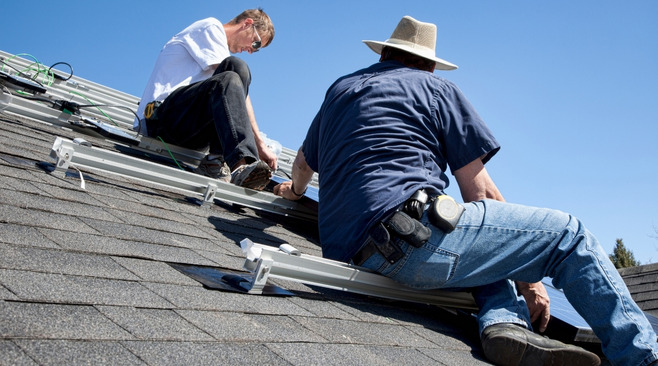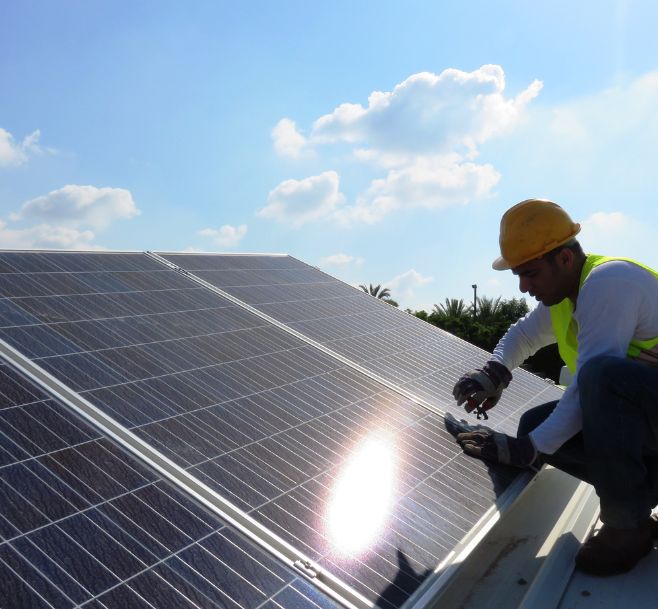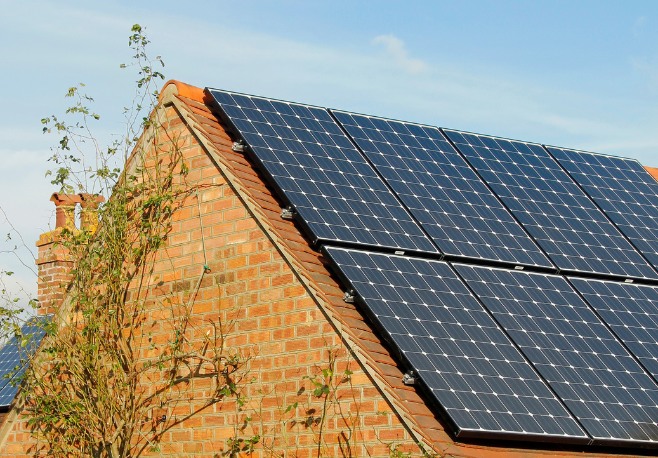Like thousands of other people in Woodend, you might be thinking about having solar panels installed. When considering a big investment like this, you'll have questions about the process.
If so, Skylamp Solar in Woodend has all the answers you need. Our expert team has knowledge and experience in the solar panel installation process and they are happy to provide advice and information to guide you through your solar journey.

Unfortunately, no.
Although most roofs in Woodend are suitable, certain materials don't lend themselves well to solar panel installations. We need to establish what roof material you have as soon as possible so we can assess whether it's viable.
The following list gives an idea of which materials are okay and which aren't:
Concrete tiles - as with clay tiles, they are removed during the installation process and replaced when the mounts have been fitted.
Aside from the roof material, we will need to know the age and state of your existing roof. As a rough guide, your roof should have at least 15 years of life left before you consider installing solar panels.
The main concern is that your roof should be able to take the weight of the array, as well as the safety issues relating to contractors working on the roof.
Before any work starts, a structural survey will be carried out that includes an inspection of your loft and roof space to determine its strength and condition. Always avoid contractors who suggest that this step is not necessary or who don't carry out a site inspection prior to the installation.
A south-facing roof is perfect for solar panels, as it will catch the most sunlight throughout the day. However, you can still have solar panels fitted, even if your roof is facing in a different direction - your array will still work, although with reduced efficiency.
North-facing roofs will receive the least amount of sunshine, so will be the least efficient. Even so, they will still provide cheaper electricity (or hot water) than your energy supplier.
To get the most out of your solar panels, your roof pitch should be between 30º and 45º, with 35º being the optimum angle for the UK. Your panels will still work outside of this range but won't be quite as efficient.
So, a south-facing roof with a pitch of 35º will be the most efficient, while solar panels facing directly east at a 90º angle (i.e. a wall) will be 50% less efficient.
It's important to understand how the orientation and slope affect your solar panel system, as this will affect its efficiency and therefore its cost-effectiveness.
A great number of people believe that there's only one type of solar panel, but there are currently two to choose from (although hybrid solar panels are now also available as a third option).
To keep things simple, here's a basic overview of what these are:

Solar PV systems are a more recent form of renewable energy that transform sunlight into electricity. PV stands for photovoltaic, referring to photons (light particles) that are turned into volts of electricity. Each panel contains photovoltaic cells that react to sunlight. Basically, photons knock electrons from the atoms of a semiconductor inside the cells, producing an electrical charge.
This charge is collected and sent as a direct current (DC) to a solar inverter that transforms it into an alternating current (AC) for use in the building.
Having been around for much longer than solar PV panels, this type is perhaps more widely known. Solar thermal uses the sun's energy to heat water (and sometimes air) rather than to generate electricity, so it is less versatile than a solar PV system.
Even so, it is a valid and viable renewable energy option that is worth considering. You reduce your energy bills and your carbon footprint, and you will eventually recover the installation costs.
In contrast to solar PV panels, thermal solar panels work by absorbing heat from the sun. This heats up a special liquid that runs through the panel in tubes. The heated liquid (usually a mixture of water and glycol) flows to a coil in a hot water tank for storage.
These days, there are two types of solar thermal panels; flat panels and evacuated tubes. Both work on the same principle, although the latter type is more efficient and generally more expensive.
These are the newest types of solar panel systems on the market today that combine the benefits of solar thermal systems by heating water and also converting the sun's energy into excess electricity to sell back to the grid. We also have a hybrid solar panel installation service.

The average fitting in Woodend takes between one and two days, taking a typical two or three-bedroom house as an example.
The type of roofing material makes a difference, as some will require extra work and more careful handling, which will extend the time taken.
Larger projects - particularly on commercial sites - will obviously take longer, but it is always our intention to install your solar system quickly and efficiently.
However, there may be instances when the work is affected by unforeseen and unavoidable circumstances. In these cases, the work could be interrupted or delayed but we will always endeavour to finish the job as soon as the situation is resolved.

The first stage is to arrange for a structural survey and inspection of your loft space and roof. During this survey, we will check for any signs of rot or unsafe joints as we must be certain that your roof will take the weight of the solar panels.
Measurements will be also taken so the team knows how to space the mounts.

On the appointed start date, the Skylamp Solar expert solar panel installers will erect scaffolding before anything else. This is to provide a safe working area for all of the staff while working on your roof.
Of course, this step will be bypassed if your solar installation is at ground level.
The solar panel mounts are fitted to the roof, according to the type of material involved. These are tightened and checked before proceeding.
The team then attaches the required number of solar panels to the mounts securely.
The tricky job of connecting the wiring comes next, and this is one of the most difficult tasks involved.
The Woodend Skylamp Solar team will test your solar panels to ensure that they are working properly.
Once they have established that all is well, they tidy up the site and dismantle the scaffolding before leaving.

The cost of installing solar panels should include the panels themselves. Always check what you are getting before signing anything or making a payment.
Skylamp Solar won't surprise you with hidden costs halfway through the job; we believe that openness and honesty are paramount in all of our business dealings.
Installation costs vary according to where you are in the UK, what type of roof you have, and the system size (for a rough guide check our post on “how many solar panels do I need”. To calculate the ideal system size for your requirements, we'll need to know:
Once we have these figures we can provide a quote.
We written a rough guide on “how much does a solar panel installation cost” if you want to check that out, whilst your here though here's an idea of what solar panels cost to install:
The 4kW solar panel system is probably the most common of all those fitted in the UK. This setup would cost between £6,000 and £8,000 and would use around 29 square metres of roof space with 16 panels. You could expect to save around £1,000 on your electricity bills annually, with a saving of as much as £27,000 over 25 years.
In contrast, a 3kW system would be £5,000 to £6,000 with 12 panels, and a 6kW system somewhere between £9,000 and £11,000 with 24 panels. The 6kW solar panel system could produce electricity bill savings of more than £40,000 in its lifetime.
To get the most out of your solar PV panels, it's best to have a solar battery storage system installed at the same time. Although this will incur additional costs, you can use electricity generated during daylight hours to power your home at night. You can also sell excess electricity back to the national grid via the smart export guarantee, meaning that your solar installation will pay for itself sooner.
The average solar thermal system cost is between £4,000 and £5,000. However, you may need to have a new hot water tank fitted if your old water cylinder or combi-boiler isn't compatible, which will obviously add to the overall cost.
Fortunately, many modern boilers are compatible, particularly in new builds.
These systems can provide between 70-90% of your domestic hot water needs throughout the year (based on a family of four), although this will drop to around 25% during the winter, according to energy saving trust (EST) data. Because of this, you'll need a backup energy source, like a boiler or immersion heater.
Of the two, you'll probably get more out of the photovoltaic system.
A thermal system will provide hot water, and (in some cases) can be connected to your central heating. The main benefit is lower energy bills and less reliance on fossil fuels.
Photovoltaic panels, on the other hand, offer the same benefits but with an added bonus: you can run all of your electrical appliances and sell excess electricity back to the national energy grid. However, this requires an extra upfront cost as you will need battery storage to do this.
Another advantage of a solar PV system is that solar electricity can be used to run heat pumps, saving you even more on energy bills.
One of the biggest benefits of the solar PV panel system is the prospect of being paid by your electricity supplier for exported electricity.
This happens under the Smart Export Guarantee (SEG) scheme that replaced the Feed-in Tariff in 2020. The UK government introduced these schemes to encourage investment in renewable energy. It's likely that this scheme will end or be altered in the near future as technology advances and the government strives to reach net zero emissions by 2050.
However, in the meantime, you will be paid an average of £200 per year under the Smart Export Guarantee for generating energy and selling it back to the grid.
PLEASE NOTE: Due to the uncertainty and turmoil in recent times surrounding the energy price cap and the energy market in general, any of the figures shown here may change drastically. On the whole, it's good news for anyone who invests in their own renewable electricity using solar power as they will make even bigger savings.


In the majority of cases planning permission from Woodend Council is not required.
Solar panel installation comes under permitted development, so you should be okay to go ahead.
Even so, you should be aware of a handful of regulations that might affect your decision to install solar panels:
While some of these rules seem vague, the main ones to focus on are the first two, concerning the height of the panels.
If you need clarification or have any queries about planning permission, get in touch and we'll go through the details with you. The best approach is to check with your local authorities if you have any doubts at all.
When you decide to have solar panels installed, it's wise to choose a professional company to do the job. This is skilled work, fitting highly technical equipment, and your investment is at risk if you employ unqualified or inexperienced contractors.
At Skylamp Solar in Woodend, we will walk you through each stage of the process, from initial contact to the time our team leaves the site. And even after this, we are here if you have any concerns or questions about your newly-fitted solar panels.
An investment in solar power is an investment in the future. You will generate your own energy and save money!

The latest domestic solar panels can generate around 250-400 watts each per hour and solar panel systems have around a 1KW - 4KW capacity. However the amount of energy a solar panel system can generate depends on several factors, including the size of the system, the location, and the amount of sunlight the panels receive.
It depends on the specific circumstances of your home. Our solar panel engineer will be able to assess your current electrical system and determine if any changes or upgrades are necessary and any associated costs.
Solar panels can be installed on a variety of roof types, including asphalt shingle, metal, tile, and flat roofs. However, some roofs may not be suitable for solar panel installations, such as those that are too old, too damaged, or too steeply sloped. A solar panel installation team will assess your roof and determine if it is suitable for solar panels.
The lifespan of a solar panel system is typically 25-30 years, and some panels may last even longer. The panels are designed to be durable and withstand exposure to the elements, but it is important to maintain the system according to the manufacturer's guidelines to ensure its longevity.